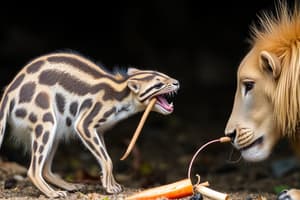Podcast
Questions and Answers
What is the primary food source for kangaroos?
What is the primary food source for kangaroos?
- Fruits
- Foliage and grasses (correct)
- Brine shrimp
- Seeds and nuts
Which of the following animals is known to feed mainly on twigs and leaves without digesting them?
Which of the following animals is known to feed mainly on twigs and leaves without digesting them?
- Flamingoes
- Sparrows
- Deer
- Sloths (correct)
What do flamingoes feed almost exclusively on?
What do flamingoes feed almost exclusively on?
- Fruits
- Brine shrimp (correct)
- Grasses and shrubs
- Seeds and nuts
Which type of animal mainly feeds on tree bark, branches, roots, stems, and leaves?
Which type of animal mainly feeds on tree bark, branches, roots, stems, and leaves?
What do herbivores primarily eat?
What do herbivores primarily eat?
Which animal has movements that involve traveling through trees from branch to branch?
Which animal has movements that involve traveling through trees from branch to branch?
Flashcards are hidden until you start studying
Study Notes
Food Habits of Animals
Food consumption differs widely throughout the animal kingdom. Herbivores primarily eat plants, while carnivores consume meat. Omnivores eat a mix of both vegetation and flesh. Several factors influence what an animal chooses to eat, such as availability, nutritional needs, size, and location. Many animals will seek foods that are high in protein, fat, carbohydrates, vitamins, minerals, fiber, and water. Understanding the eating habits of specific animals helps us better manage populations and ensure they receive proper nutrition. Some examples of diverse diets within the animal kingdom include:
- Giraffes are mainly browsers, consuming mostly twigs and leaves without digesting them due to their lengthy necks.
- Kangaroos generally feed on foliage and grasses.
- Deer prefer grasses, shrubs, and fruits.
- Sloths are essentially leaf eaters, with a low metabolism.
- Sparrows prefer seeds and nuts, though they will also eat small insects.
- Flamingoes feed almost exclusively on brine shrimp.
- Beavers feed mainly on tree bark, branches, roots, stems, and leaves.
Movements of Animals
Animals move in response to numerous stimuli, including hunger, the need to mate or migrate, defense against enemies, and escaping danger. Their movements vary by species and habitats. For example:
- Monkeys travel through trees from branch to branch.
- Butterflies fly thousands of miles annually during migration.
- Dolphins swim long distances looking for prey.
- Lemurs jump long distances because they are arboreal.
- Elephants walk long distances to find water and food.
- Sea otters swim rapidly and dive deep to catch their meal.
- Plankton drift along ocean currents.
Research continues to expand our knowledge of animal movement patterns, helping us better comprehend the complex behaviors governing life on Earth.
Studying That Suits You
Use AI to generate personalized quizzes and flashcards to suit your learning preferences.



